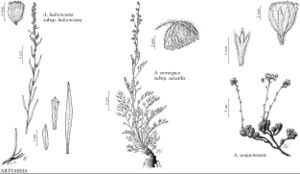Difference between revisions of "Artemisia norvegica subsp. saxatilis"
Publ. Carnegie Inst. Wash. 326: 58. 1923.
FNA>Volume Importer |
FNA>Volume Importer |
||
| Line 14: | Line 14: | ||
|name=Artemisia arctica | |name=Artemisia arctica | ||
|authority=Lessing | |authority=Lessing | ||
| − | }}{{Treatment/ID/Synonym | + | }} {{Treatment/ID/Synonym |
|name=Artemisia arctica subsp. beringensis | |name=Artemisia arctica subsp. beringensis | ||
|authority=(Hultén) Hultén | |authority=(Hultén) Hultén | ||
| − | }}{{Treatment/ID/Synonym | + | }} {{Treatment/ID/Synonym |
|name=Artemisia arctica subsp. comata | |name=Artemisia arctica subsp. comata | ||
|authority=(Rydberg) Hultén | |authority=(Rydberg) Hultén | ||
| − | }}{{Treatment/ID/Synonym | + | }} {{Treatment/ID/Synonym |
|name=Artemisia arctica subsp. ehrendorferi | |name=Artemisia arctica subsp. ehrendorferi | ||
|authority=Korobkov | |authority=Korobkov | ||
| − | }}{{Treatment/ID/Synonym | + | }} {{Treatment/ID/Synonym |
|name=Artemisia arctica var. saxatilis | |name=Artemisia arctica var. saxatilis | ||
|authority=(Besser) Y. R. Ling | |authority=(Besser) Y. R. Ling | ||
| − | }}{{Treatment/ID/Synonym | + | }} {{Treatment/ID/Synonym |
|name=Artemisia comata | |name=Artemisia comata | ||
|authority=unknown | |authority=unknown | ||
| − | }}{{Treatment/ID/Synonym | + | }} {{Treatment/ID/Synonym |
|name=Artemisia norvegica var. piceetorum | |name=Artemisia norvegica var. piceetorum | ||
|authority=S. L. Welsh & Goodrich | |authority=S. L. Welsh & Goodrich | ||
| Line 47: | Line 47: | ||
|elevation=0–3800 m | |elevation=0–3800 m | ||
|distribution=Alta.;B.C.;Yukon;Alaska;Calif.;Colo.;Mont.;Utah;Wash.;Wyo.;e Asia (Russian Far East). | |distribution=Alta.;B.C.;Yukon;Alaska;Calif.;Colo.;Mont.;Utah;Wash.;Wyo.;e Asia (Russian Far East). | ||
| − | |discussion=<p>Variation within Artemisia norvegica in North America is not well understood and, for that reason, this treatment represents a conservative taxonomy with only one subspecies for the flora area. Subspecies saxatilis differs from typical A. norvegica primarily by its larger heads. European plants have involucres less than 10 mm in diameter. Chromosome number may be used to justify separation of taxa either at the level of subspecies or species. If separated as distinct species, then A. arctica is the name for North American plants. The diploid A. arctica (2n = 18) and tetraploid A. comata (2n = 36) are treated as separate species by R. Elven et al. (pers. comm.).</p> | + | |discussion=<p>Variation within <i>Artemisia norvegica</i> in North America is not well understood and, for that reason, this treatment represents a conservative taxonomy with only one subspecies for the flora area. Subspecies saxatilis differs from typical <i>A. norvegica</i> primarily by its larger heads. European plants have involucres less than 10 mm in diameter. Chromosome number may be used to justify separation of taxa either at the level of subspecies or species. If separated as distinct species, then A. arctica is the name for North American plants. The diploid A. arctica (2n = 18) and tetraploid A. comata (2n = 36) are treated as separate species by R. Elven et al. (pers. comm.).</p> |
|tables= | |tables= | ||
|references= | |references= | ||
| Line 71: | Line 71: | ||
|publication year=1923 | |publication year=1923 | ||
|special status= | |special status= | ||
| − | |source xml=https://jpend@bitbucket.org/aafc-mbb/fna-data-curation.git/src/ | + | |source xml=https://jpend@bitbucket.org/aafc-mbb/fna-data-curation.git/src/8f726806613d60c220dc4493de13607dd3150896/coarse_grained_fna_xml/V19-20-21/V19_918.xml |
|tribe=Asteraceae tribe Anthemideae | |tribe=Asteraceae tribe Anthemideae | ||
|genus=Artemisia | |genus=Artemisia | ||
Revision as of 15:16, 18 September 2019
Perennials, 25–40(–60) cm (not cespitose), mildly aromatic (roots often horizontal, woody). Stems 1–3, erect to ascending, green or reddish, simple, glabrous or sparsely tomentose. Leaves mostly basal (in rosettes, petiolate), bright green; blades (basal) broadly lanceolate, 5–8(–10) × 2–3(–4) cm, 1–3-pinnately lobed (apical lobes 1–7 × 1.5–3 mm; mid cauline sessile, pinnately lobed; on flowering stems, sessile, linear, entire), faces glabrous or hairy. Heads (nodding, proximalmost on peduncles to 50 mm) in racemiform arrays 10–17 × 1–2 cm. Involucres globose, (4–)5–8 × 4–10 mm. Phyllaries ovate-lanceolate to elliptic (margins dark brown to black), sparsely hairy to villous. Florets: pistillate 6–20; bisexual (30–)50–70; corollas yellow or red-tinged, 1.5–2.5(–3.5) mm, long-hairy. Cypselae ovoid-oblong (angular), ca. 2.5 mm, glabrous or villous. 2n = 18, 36.
Phenology: Flowering mid–late summer.
Habitat: Coastal, arctic, subalpine to alpine habitats, boreal forests, moist soils
Elevation: 0–3800 m
Distribution

Alta., B.C., Yukon, Alaska, Calif., Colo., Mont., Utah, Wash., Wyo., e Asia (Russian Far East).
Discussion
Variation within Artemisia norvegica in North America is not well understood and, for that reason, this treatment represents a conservative taxonomy with only one subspecies for the flora area. Subspecies saxatilis differs from typical A. norvegica primarily by its larger heads. European plants have involucres less than 10 mm in diameter. Chromosome number may be used to justify separation of taxa either at the level of subspecies or species. If separated as distinct species, then A. arctica is the name for North American plants. The diploid A. arctica (2n = 18) and tetraploid A. comata (2n = 36) are treated as separate species by R. Elven et al. (pers. comm.).
Selected References
None.
